A brief introduction of nanoparticle applications in agriculture from the Connecticut Agricultural Experiment Station
There are currently about 7.67 billion people on Earth, and by 2050 the population is expected to increase to nearly 9.8 billion.1 That is a lot of people who all need to eat. According to the Food and Agricultural Organization of the United Nations, this means that we will need to increase agricultural productivity by at least 70% to achieve and maintain global food security.2,3 Unfortunately, significant negative pressure against this goal will continue to build from a changing climate, including more frequent temperature and drought extremes. Similarly, increased activity of crop pests and pathogens due directly to an altered climate are predicted to reduce rice, wheat and maize yields by up to 25%.2 Therefore, uncovering new strategies to improve crops’ resistance to pests is a critically important task for agricultural scientists. Finding these new strategies is an important goal of some of our nanoparticle research at the Connecticut Agricultural Experiment Station, including collaborations with the Center for Sustainable Nanotechnology.

Copper, manganese and zinc are very important in protecting plant health, but the problem is they don’t move freely within the plant — if you spray them on the leaves, they won’t move down to the roots.
Dr. Wade Elmer, The Connecticut Post, August 9, 2018
You may know people who take vitamin C when they catch a cold; this antioxidant will assist in defending against peroxides and other symptoms caused by the germ. Interestingly, the same is true for plants and for diseases such as Fusarium, which is a kind of plant fungus in the soil. Some Fusarium species are very economically important due to their devastating impact on a wide range of crops, including wheat, soybean and vegetables. When plants are under stress, they need a lot more of these nutrients, just like people do. For example, we know that certain nutrients can improve plant resistance to infection; this is particularly important in the roots for fungal pathogens in the soil.4 However, when plants are under stress, they often can’t access the amounts needed, either from the soil directly or from applications to their leaves.
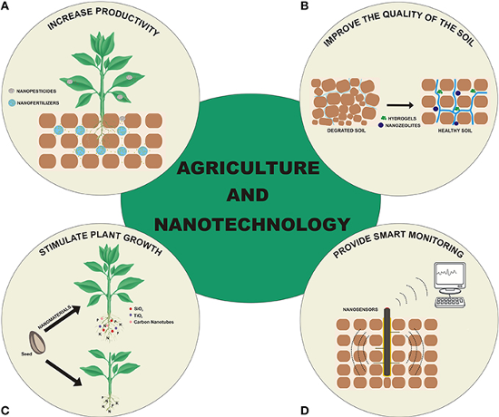
For example, with experiments applying nanoparticles to leaves, we found the copper phosphate nanosheets could enhance resistance to fungus in tomato and watermelon,6,7 and copper oxide nanoparticles also had positive effects in tomato and eggplant when applied to diseased soil.8
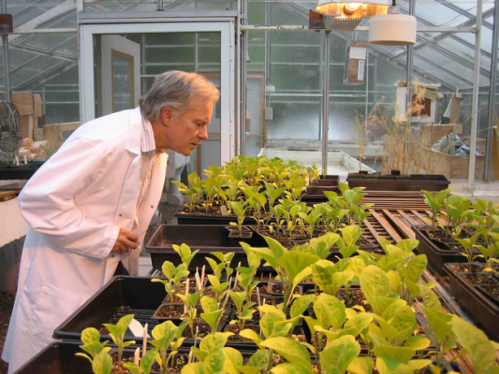
When you apply nano-scale copper to the shoots of plants, a lot of copper ends up in their root system and suppresses the diseases.
Research finding based on applying copper oxide nanoparticles to tomato and eggplant leaves, Environmental Science: Nano, 20168
Nanoparticles (particles smaller than 100 nm in at least one dimension) have great potential in agriculture. For example, micronutrients (the major essential nutrients your body needs) don’t move around inside plants very well and plants can’t easily access them from many soils, yet they play pivotal roles in plant root health. We have investigated if spraying plant leaves with micronutrient nanoparticles can affect plant health in pathogen-infested soils. In one greenhouse experiment, we found that nanoparticles of copper oxide, manganese oxide, or zinc oxide reduced disease in tomato and eggplant by 28-31% when compared to untreated controls.8
In a parallel field study, these same materials were sprayed onto the leaves of tomato and eggplant transplants that were later transferred to fields that were heavily infested with a fungal pathogen. Nanoparticles of copper oxide on the eggplants decreased the presence of disease and increased fruit yield by 34% when compared to controls that weren’t sprayed with the nanoparticles. In this field study, the nanoparticles were also found to be more effective than traditional fungicides; in this case, a $44 investment in copper oxide nanoparticles per acre led to a nearly $10,000 increase in crop production! Importantly, this type of approach could not only be cost-effective but also could lead to dramatic reductions in the how much pesticides and fertilizers farmers need to apply, which could have important impacts on public and environmental health.
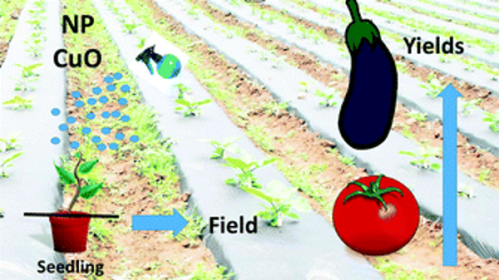
In a follow up greenhouse study focused on understanding how these nanoparticles help the crops fight disease, my colleagues in the Center for Sustainable Nanotechnology found that the expression of genes related to plant defense were proactively upregulated in the presence of the nanoparticle and the pathogen.6 Although our work is at the experimental stage, the results are quite promising and conversations on how to transfer this technology to the field and to growers are now underway.9
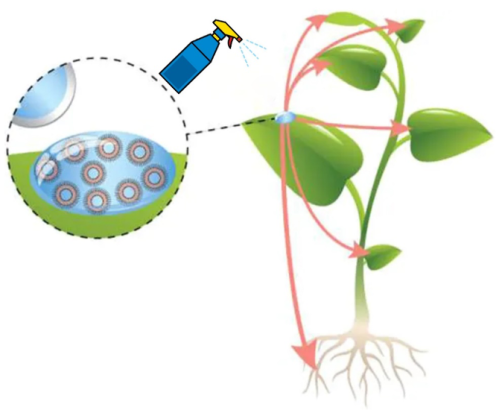
We need to grow enough food to feed the people we have on the planet.
Dr. Jason C. White, New Haven Register, December 26, 2016
Based on all of this research, our team firmly believes that nanotechnology can and will provide a range of highly effective strategies that can help to maximize global food production and achieve global food security. However, agroecosystems are incredibly diverse and complex, and as such, finding solutions (nano-enabled or otherwise) to the problems of inefficient use of fertilizers, pesticides, energy, and water, remains daunting. Not surprisingly, solutions have been rather elusive, and in addition, achieving global and sustainable food security requires consideration of the entire food system. Beyond crop production, many other sectors including animal production and health, foodstuff preservation, and waste remediation can all benefit from the application of nanotechnology and will receive increased attention in the future.11,12
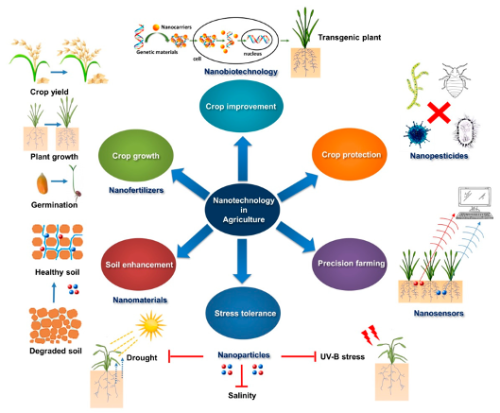
REFERENCES
- Nelson, G. et al. Food Security, Farming, and Climate Change to 2050: scenarios, results, policy options. 2010. International Food Policy Research Institute, 172. doi: 10.2499/9780896291867
- Alexandratos, N. and Bruinsma, J. World Agriculture: Towards 2015/2030: The 2012 Revision. ESA Working Paper No. 12-03. Rome, Food and Agricultural Organization of the United Nations. 2012. doi: 10.22004/ag.econ.288998
- Ray, D. et al. Yield Trends Are Insufficient to Double Global Crop Production by 2050. PLoS One, 2013, 8, e66428. doi: 10.1371/journal.pone.0066428
- Khush, G., Challenges for meeting the global food and nutrient needs in the new millennium. Proceedings of the Nutrition Society, 2001, 60(1), 15-26. doi: 10.1079/PNS200075
- Fraceto, L. et al. Nanotechnology in agriculture: which innovation potential does it have? Frontiers in Environmental Science, 2016, 4, 20. doi: 10.3389/fenvs.2016.00020
- Borgatta, J. et al. Copper based nanomaterials suppress root fungal disease in watermelon (Citrullus lanatus): role of particle morphology, composition and dissolution behavior. ACS Sustainable Chemistry & Engineering, 2018, 6(11), 14847-14856. doi: 10.1021/acssuschemeng.8b03379
- Ma, C., et al. Time-dependent transcriptional response of tomato (Solanum lycopersicum L.) to Cu nanoparticle exposure upon infection with Fusarium oxysporum f. sp. lycopersici. ACS Sustainable Chemistry & Engineering, 2019, 7(11), 10064-10074.
doi: 10.1021/acssuschemeng.9b01433 - Elmer, W. and White, J. The use of metallic oxide nanoparticles to enhance growth of tomatoes and eggplants in disease infested soil or soilless medium. Environmental Science: Nano, 2016 3(5), 1072-1079. doi: 10.1039/C6EN00146G
- Elmer, W., et al. Effect of metalloid and metal oxide nanoparticles on Fusarium wilt of watermelon. Plant Disease, 2018 102(7), 1394-1401. doi: 10.1094/PDIS-10-17-1621-RE
- Karny, A., et al. Therapeutic nanoparticles penetrate leaves and deliver nutrients to agricultural crops. Scientific Reports, 2018, 8(1), 7589. doi: 10.1038/s41598-018-25197-y
- Kah, M., Tufenkji, N. & White, J. Nano-enabled strategies to enhance crop nutrition and protection. Nature Nanotechnology, 2019, 14(6), 532-540. doi: 10.1038/s41565-019-0439-5
- Shang, Y., et al. Applications of nanotechnology in plant growth and crop protection: a review. Molecules. 2019, 24(14), 2558. doi: 10.3390/molecules24142558
